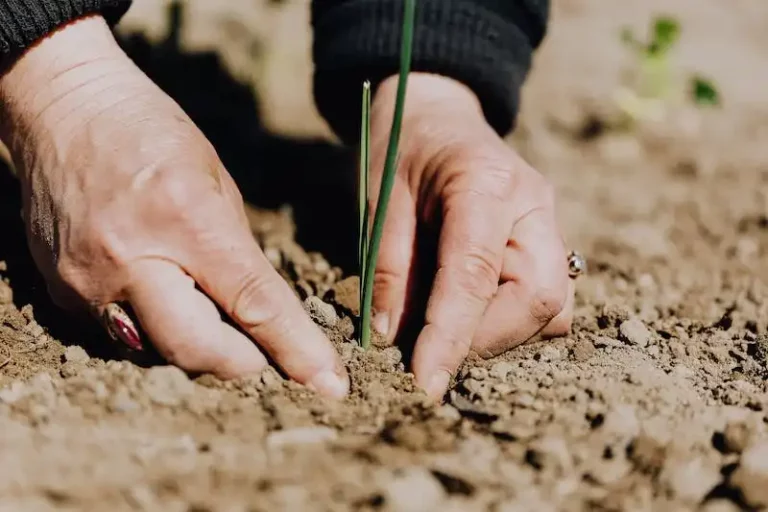Chickweed is a common weed that can be found in many landscapes and gardens. It is an annual plant that grows in moist, shady areas with fertile soils. Chickweed has a shallow rootstock and features small, smooth, oval-shaped leaves along with small white flowers with five petals.
Chickweed can be a nuisance in gardens and landscapes as it can quickly spread and compete with desired plants for nutrients and moisture. It germinates in early spring or late winter and grows well in cool, moist conditions. Chickweed is hardy and can survive winter frosts, resulting in its rapid growth in the spring.
There are several methods to get rid of chickweed, but it is essential to choose the best way depending on the desired results and the size of the infestation. Manual removal is one of the most common and safe methods. It involves pulling the weeds out manually, ensuring that the roots are carefully removed to prevent regrowth. Applying mulch or organic solutions can also prevent chickweed from germinating and developing in desired areas.
For larger infestations or hardy chickweed species, chemical treatments may be necessary. However, using chemicals should be done with caution, primarily if you have pets or wildlife foraging in the treated areas. Contacting a professional gardener or landscaper can provide guidance on the best chemical treatments for your particular situation.
In conclusion, chickweed is a common weed that can cause problems in gardens and landscapes. Understanding how it grows, its features, and the desired outcome is essential when choosing the best method to kill chickweed. Whether you manually remove it, apply organic solutions, or use chemicals, it is crucial to act promptly and prevent further spread to maintain a healthy and well-watered garden or landscape.
How to Control Chickweed
Chickweed is a common weed that can quickly take over a lawn or garden if left unchecked. If you’re dealing with a chickweed infestation, it’s important to take action to control and prevent its spread. Here are some methods you can use to effectively control chickweed:
- Manually remove chickweed: One of the best ways to control chickweed is to physically remove it from the affected areas. This can be done by hand-pulling the weed or using a handheld weeding tool. Make sure to remove the entire plant, including the roots, to prevent regrowth.
- Prevent chickweed seedlings: To prevent chickweed from spreading, it’s important to stop seedlings from germinating. You can do this by keeping your lawn well-watered and properly mowing the grasses. Additionally, maintaining a thick and healthy lawn will help prevent chickweed from taking hold.
- Use herbicides: If the chickweed infestation is severe, using herbicides may be necessary. There are different types of herbicides available, both organic and chemical-based. It’s important to choose an appropriate herbicide for your specific needs and follow the instructions carefully. Postemergent herbicides are effective for controlling chickweed that has already germinated, while preemergent herbicides can prevent chickweed from sprouting.
- Implement cultural practices: Incorporating certain cultural practices into your gardening routine can help control chickweed. For instance, spacing plants appropriately and providing proper airflow can prevent chickweed from spreading. Mulching your garden can also prevent chickweed from taking hold.
- Consider using barriers: To prevent chickweed from spreading to desired areas, you can use barriers such as plastic mulch or landscaping fabric. These barriers will stop chickweed seeds from getting the light they need to germinate. Apply these barriers before the chickweed grows.
- Encourage natural predators: Chickweed can be a source of food for certain pests or animals. By attracting natural predators, such as birds or beneficial insects, you can help control the chickweed population in your garden or lawn. Providing appropriate features, such as bird feeders or insect-friendly plants, can help attract these predators.
Whether you choose to control chickweed through manual effort, herbicides, cultural practices, or natural predators, it’s important to take action as soon as possible. The longer the chickweed is allowed to grow and spread, the more difficult it can be to eliminate.
What Is Chickweed
Chickweed is a common winter annual weed that can be found in many areas. It is a shallow-rooted plant that spreads by seed and can quickly take over large areas if left unchecked. Chickweed is often considered a pest because it can compete with desirable plants for resources and nutrients.
Chickweed has many uses and is safe to eat. It can be used in salads, soups, and stir-fries. In fact, it has a slightly sweet and nutty flavor that many people enjoy. Chickweed is also used in herbal remedies and has been used for centuries to treat various ailments.
When it comes to removing chickweed, there are several methods that can be effective. One common method is to manually pull the weeds out with a shovel or by hand. This is best done when the soil is wet, as the weeds are easier to remove. Another method is to mow over the chickweed with a lawn mower, although this may not completely kill the plants. Chickweed can also be controlled by applying certain chemicals, although this should be done with caution as it can harm other plants and wildlife.
If you’re looking for a natural way to prevent chickweed from taking over your landscape, there are some steps you can take. One method is to create a mulch barrier between your plants and the chickweed. This can help to prevent the weed seeds from sprouting. Another option is to use organic weed killers, although these may not be as effective as chemical solutions. Finally, it’s important to keep your lawn and gardens healthy, as healthy soils and well-established grasses can help to prevent chickweed from becoming a problem.
In conclusion, chickweed is a common and somewhat sticky weed that can be found in many areas. It is best managed through integrated weed management practices, including manual removal, mulching, and professional services if necessary. Chickweed has been used in Europe for foraging and has certain uses in herbal remedies, but it can quickly spread and become a nuisance in landscaped and planting areas. It’s important to take steps to prevent chickweed from becoming established, as it can be difficult to control once it has taken hold.
How to Kill Chickweed
Chickweed is a common and stubborn weed that can quickly take over your garden or lawn, forming dense mats that smother other plants. This sticky, low-growing weed can develop roots at multiple locations along its stem, making it difficult to remove once it takes hold.
Foraging and fertilization methods can contribute to chickweed growth, so it’s important to control it before it spreads. There are several effective ways to kill chickweed, both chemical and non-chemical.
One of the simplest methods is to remove chickweed by hand. If the infestation is small or there are only a few key spots, you can choose to manually remove the plants by pulling them up from the rootstock. Make sure to wear gloves to protect your hands from the hairy and sticky stems of chickweed. Be thorough and try to remove as much of the root as possible to prevent regrowth.
If the infestation is larger or more widespread, you can use a mower to cut down the chickweed. This non-chemical method may not completely eliminate the weed, but it can help to keep it under control in landscaped areas. Just be sure to clean the mower thoroughly afterward to avoid spreading the seeds to other parts of your garden or lawn.
If you prefer a chemical approach, you can use a selective herbicide specifically designed to target broadleaf weeds like chickweed. Follow the instructions on the herbicide label carefully, as some products require multiple applications for effective control. These herbicides work by killing the chickweed through contact or by being absorbed into the plant’s tissues.
For those who want to avoid chemicals altogether, there are some natural methods to consider. Solarization can be an effective way to manage chickweed. This involves covering the affected area with plastic to raise the soil temperature and kill any weed seeds or plants present. This method requires a few weeks of sunlight and warm temperatures to be successful.
To prevent future chickweed infestations, it’s important to manage your garden or lawn properly. This includes regular weeding and maintaining healthy soils with proper fertilization. Avoid over-watering, as chickweed thrives in moist soils. Additionally, maintaining a thick layer of mulch around your plants can help to smother any chickweed seeds that may be present.
Chickweed is a winter annual weed, which means it germinates in the fall and grows throughout the winter. By taking proactive measures in the fall, such as removing any chickweed plants before they flower and go to seed, you can prevent a larger infestation in the spring. This is also the best time to treat with herbicides, as the plants are actively growing and more susceptible to the chemicals.
Although chickweed can be a nuisance in your garden or lawn, with the right methods and effort, you can successfully rid your property of this pesky weed. Whether you choose chemical or non-chemical methods, always prioritize the health and safety of your plants and soils.
Living With Chickweed
Chickweed is a common and hardy weed that can quickly take over a garden or lawn if not properly controlled. While there are methods to kill chickweed, it can still be a challenge to completely eradicate from your yard. This practical guide will provide information on how to live with and manage chickweed in your outdoor spaces.
Chickweed is a naturally growing weed that spreads easily, thanks to its ability to produce a large number of seeds. It thrives in areas with moist soil and plenty of sunlight, making it a common sight during the winter and early spring months. Chickweed’s growth is somewhat stunted during the hot summer months, but it can still sprout in shaded areas or with sufficient moisture.
To control the spread of chickweed, it is important to take a proactive approach. Regularly mowing your lawn or landscape can help prevent chickweed from developing into a large problem. Cutting the weed before it flowers and forms seeds will help keep its growth in check.
There are also chemical weed killers available that can be applied to areas where chickweed is present. However, it is important to follow the instructions carefully and choose a product that is safe for the surrounding plants and the environment. Some weed killers may also require multiple applications to effectively kill the chickweed.
If you prefer a more natural approach, there are organic methods to control chickweed as well. These methods include hand pulling the weed, using a professional weed control service, or using homemade herbicidal mixtures. One popular homemade mixture is vinegar and water, which can be applied directly to the weed to kill it.
Another way to prevent chickweed from taking over your outdoor spaces is to create conditions that are not favorable for its growth. This includes improving soil drainage, limiting excessive watering, and providing sufficient sunlight to your desired plants. By making your garden or lawn more competitive, you can discourage chickweed from taking hold.
It is important to note that even with the best efforts, it may be difficult to completely eliminate chickweed from your yard. The weed is hardy and can quickly grow back from remaining roots or seeds in the soil. However, by following a regular maintenance program and staying vigilant, you can keep chickweed under control and enjoy a healthier outdoor environment.
In conclusion, living with chickweed may require some effort, but it is possible to manage and control this invasive weed. Whether you choose to use chemical treatments, natural methods, or a combination of both, it is important to stay proactive and consistent in your approach. By preventing the spread of chickweed and creating conditions that are less conducive to its growth, you can enjoy a healthier and more beautiful outdoor space.
Source: link



